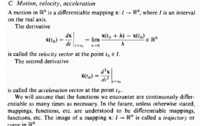I just have a very general question. I know how to find the equation for a line tangent to a curve, given a point; however, I now wonder if anyone could give me a real practical reason for wanting to do so, other than to answer questions on an exam or in a calculus text; i.e., what would be a real-life, practical example of when someone would need to do that?
So often, calculus instruction leaves out such interesting information, which makes the whole process dry and uninteresting. It reminds me of the oft-heard question that teachers must deal with: "Why do we have to know this stuff? I'll never, ever use it in my life." lol!
Since I am am old man, and not in any calculus class, I would like to know the answer strictly out of interest's sake, so my motive is, hopefully, 'purer' than that of a bored high school math student. I just want to know, because it's interesting.
I just want to know, because it's interesting.
So often, calculus instruction leaves out such interesting information, which makes the whole process dry and uninteresting. It reminds me of the oft-heard question that teachers must deal with: "Why do we have to know this stuff? I'll never, ever use it in my life." lol!
Since I am am old man, and not in any calculus class, I would like to know the answer strictly out of interest's sake, so my motive is, hopefully, 'purer' than that of a bored high school math student.

